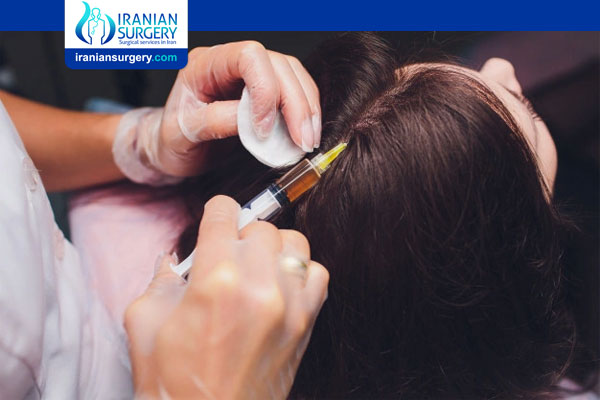PRP therapy process
Platelet-rich plasma (PRP) Therapy for Hair Loss
What is PRP Therapy?
PRP (platelet-rich plasma) therapy for hair loss is a three-step medical treatment in which a person’s blood is drawn, processed, and then injected into the scalp.
Some in the medical community think that PRP injections trigger natural hair growth and maintain it by increasing blood supply to the hair follicle and increasing the thickness of the hair shaft. Sometimes this approach is combined with other hair loss procedures or medications.
About Iranian Surgery
Iranian surgery is an online medical tourism platform where you can find the best doctors in Iran. The price of PRP Therapy for hair loss in Iran can vary according to each individual’s case and will be determined by an in-person assessment with the doctor.
For more information about the cost of PRP Therapy for hair loss in Iran and to schedule an appointment in advance, you can contact Iranian Surgery consultants via WhatsApp number 0098 901 929 0946. This service is completely free.
Before PRP Therapy for Hair Loss
PRP for hair loss side effects
Because PRP therapy involves injecting your own blood into your scalp, you aren’t at risk for getting a communicable disease.
Still, any therapy that involves injections always carries a risk of side effects such as:
. Injury to blood vessels or nerves
. Infection
. Calcification at the injection points
. Scar tissue
There’s also the chance that you could have a negative reaction to the anesthetic used in the therapy. If you decide to pursue PRP therapy for hair loss, let your doctor know in advance about your tolerance to anesthetics.
Risks of PRP for hair loss
Be sure to report all medications you’re on before the procedure including supplements and herbs.
When you go for your initial consultation, many providers will recommend against PRP for hair loss if you:
. Are on blood thinners
. Are a heavy smoker
. Have a history of alcohol or drug misuse
You might also be rejected for treatment if you’ve been diagnosed with:
. Acute or chronic infections
. Cancer
. Chronic liver disease
. Chronic skin disease
. Hemodynamic instability
. Hypofibrinogenemia
. Metabolic disorder
. Platelet dysfunction syndromes
. Systemic disorder
. Sepsis
. Low platelet count
. Thyroid disease
During PRP Therapy for Hair Loss
PRP therapy process
PRP therapy is a three-step process. Most PRP therapy requires three treatments 4–6 weeks apart.
Maintenance treatments are required every 4–6 months.
. Step 1
Your blood is drawn — typically from your arm — and put into a centrifuge (a machine that spins rapidly to separate fluids of different densities).
. Step 2
After about 10 minutes in the centrifuge, your blood will have separated into in three layers:
. Platelet-poor plasma
. Platelet-rich plasma
. Red blood cells
. Step 3
The platelet-rich plasma is drawn up into a syringe and then injected into areas of the scalp that need increased hair growth.
There hasn’t been enough research to prove whether PRP is effective. It’s also unclear for whom — and under what circumstances — it’s most effective.
According to a recent study, “Although PRP has sufficient theoretical scientific basis to support its use in hair restoration, hair restoration using PRP is still at its infancy. Clinical evidence is still weak.”
After PRP Therapy for Hair Loss
How long does it last?
PRP is not a cure for conditions that cause hair loss. For this reason, a person would need to receive multiple PRP treatments over time to maintain hair growth results. The same is true of medications that doctors commonly use to treat androgenetic alopecia, such as topical minoxidil (Regaine) and oral finasteride (Propecia).
The doctor’s recommendations for how often a person should have PRP will vary depending on a person’s condition and the results of their initial treatment. The doctor may suggest having maintenance injections every 4–6 months once hair loss is under control.
Sources:


